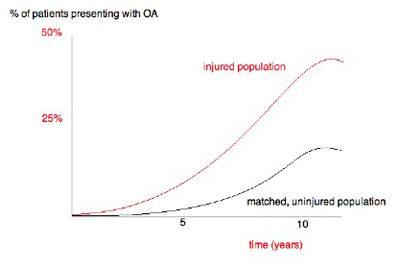We clinicians are often vexed by the following question posed by solicitors in personal injury cases: “If the patient was likely to develop a degenerative condition at some point in the future, how many years has this injury brought forward the onset of the degenerative condition?”
On the face of it, it is a fairly simple question for an expert with years of clinical experience, you might say. However, I think that is to misunderstand the complexity of the question. I will attempt to explain, from a clinicianís point of view.
The common scenario is a radiograph (X-ray) of a recently injured joint, showing degenerative changes: ‘wear and tear’ arthritis, known as osteoarthritis (OA). The patient denies any pre-injury symptoms.
The first difficulty is that radiographic changes do not correlate well with symptoms. The degenerative change may well have never been detected as the patient remained asymptomatic for the whole of their life. Thus, we cannot know the prevalence of asymptomatic, but radiographically-present, OA in the population. Because we cannot ethically X-ray large numbers of joints in large numbers of patients to find out, the information will remain elusive.
We cannot therefore know what proportion of those patients will then progress to being symptomatic.
To answer the question, though, we also need to know the effect of the injury on the already ‘at-risk’ joint. We may know the risk of progression to OA after certain injuries (eg wrist arthritis after ligament rupture or scaphoid fracture) because large studies have followed those patients over many years. It may not be the same as the effect on an already compromised joint, and matching subgroups with OA for any given injury are likely to be scarce.

Add to that the following difficulty: even if we knew precisely what proportion of patients would become symptomatic after OA was detectable on their X-rays, the natural progression of OA for the injured group is likely to be different. The figure shows a hypothetical representation of two populations.
It may well be that fewer patients in the uninjured population eventually develop OA than in the injured population, and the slope of the curves may be very different. How could we give a figure for an individual patientís ëyears brought forwardí even if the information was at our fingertips (which it isn’t)?
My point is that this is guesswork (choosing an arbitrary point on two non-parallel curves at which to extrapolate the number of years the curve has shifted to the left in the figure above), based on guesswork (rate of progression of OA in already degenerate joints when injured), based on guesswork (prevalence of asymptomatic OA in the population).
That, in my view, represents an attribution of scientific credibility from the expert which cannot be based on anything resembling fact, and should be discouraged. An alternative wording to establish quantum would be helpful.


